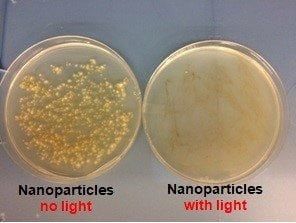
A new way of wiping out the deadly hospital superbug MRSA is being developed.
The life-threatening bacteria can cripple a hospital as it spreads quickly and is resistant to treatment.
But scientists say that they are now making advances in a new technique that avoids antibiotics.
Instead, they are using light to activate oxygen, which then wipes out antibiotic-resistant bacteria.
Researchers say that the method also could be used to treat other microbial infections, and possibly even cancer.
Clinical facilities currently have few alternatives when trying to rid their patients of MRSA.
One recent study found that disinfecting every patient admitted to an acute-care setting cut the rate of bloodstream infections in half.
But such a procedure isn’t feasible at most hospitals.
Doctor Peng Zhang, of the University of Cincinnati in the US, said: “Instead of resorting to antibiotics, which no longer work against some bacteria like MRSA, we use photosensitisers, mostly dye molecules, that become excited when illuminated with light.
“Then, the photosensitisers convert oxygen into reactive oxygen species that attack the bacteria.”
Although other teams have experimented with using such types of photocatalysts to kill bacteria, they did not destroy enough microorganisms to effectively shake off infections.
Photosensitisers in a molecular form tend to not be corralled enough to do significant damage. In addition, many of them are hydrophobic. This makes it difficult to disperse them.
To overcome these challenges, the reseachers set out to design a new, water-dispersible, hybrid photosensitiser – one that includes noble metal nanoparticles decorated with amphiphilic polymers to entrap the molecular photosensitizers.
The team showed that the new nanoparticle photosensitiser was much more effective at killing a variety of bacteria than corresponding formulations that did not contain the metal particles.
Dr Zhang said these nanoparticles provide two benefits. The metal has a plasmonic enhancement effect that promotes the generation of more reactive oxygen species, while also concentrating the photosensitszers in one place for a more localised hit to the bacterial cells.
He explained: “If you want to attack a castle, and you just let all these people attack individually, it is not very effective.
“Instead, if you have the same number of people grouped together attacking the castle at one point, it is possible to cause more damage.”
Dr Zhang has a patent related to the design of hybrid photosensitisers, which can be formulated into a spray or gel.
He says that once the spray is developed into a product, medical professionals could put it on any surface and then illuminate it with blue or red light to clean away the bacteria, including MRSA, that may be present.
Dr Zhang said the method also shows promise in direct wound applications to eliminate infection and assist in healing.
He has recently performed experiments on laboratory samples of human skin and found that the photosensitiser didn’t kill skin cells.
Dr Zhang said the nanoparticles are also ideal for destroying skin cancer cells.
The findings were due to be presented at the annual national meeting of the American Chemical Society (ACS) in Boston.